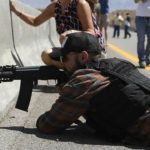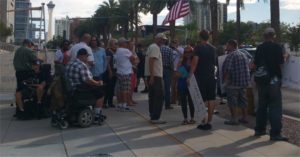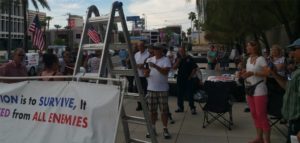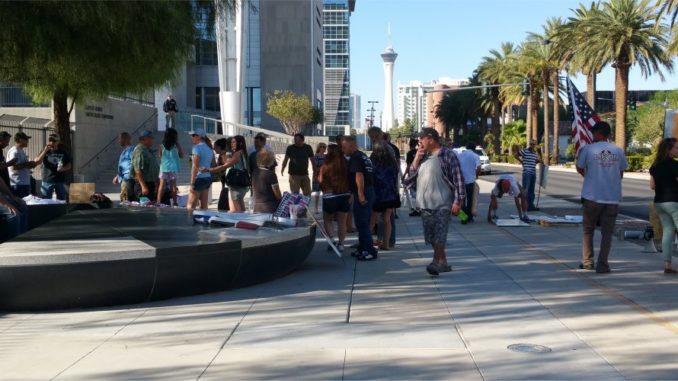Judge Navarro vs. the Jury
by Shari Dovale
Judge Gloria Navarro has had a difficult time getting the defendants and spectators to understand that Jury Nullification is, well… a bad thing. She has made her rulings. She has given her orders. She has specifically forbidden nullification from being used in the case of US v. Bundy et. al. She has not, however, said that jury nullification is illegal.
In fact, Nullification is legal. As much as Gloria Navarro would like the jurors to believe otherwise, and that they can be punished for not returning a verdict she approves of, the standard has been in place for nearly 350 years.
A 1670 English ruling in a case against William Penn and William Mead, the jury refused to convict Penn and Mead. This infuriated the panel of judges, who locked up the jury without food or water until they arrived at a “correct” verdict. The jury refused to change their verdict, resulting in Penn and Mead’s acquittal.
The justices were not satisfied. They fined the jurors and sent them to prison until the fine was paid. Edward Bushell was one of the jurors who refused to pay the fine, and remained in prison as a result. He appealed his case, where a higher court overruled his punishment.
The judge’s ruling established the enduring principle that jurors cannot be punished for their verdicts.
Jury nullification occurs when a jury returns a verdict of “Not Guilty” despite its belief that the defendant is guilty of the violation for which they have been charged. The jury in effect nullifies a law that it believes is wrongly applied to the defendant.
There have been several noteworthy cases over the years of jury nullification. The most famous case is the 1735 trial of John Peter Zenger, charged with printing seditious libels of the Governor of the Colony of New York, William Cosby. Despite the fact that Zenger clearly printed the alleged libels (the only issue the court said the jury was free to decide, as the court deemed the truth or falsity of the statements to be irrelevant), the jury nonetheless returned a verdict of “Not Guilty.”
In 1920, The Constitution was amended to prohibit the sale of alcohol because a majority who did not drink wished to impose their morals on the minority of citizens who did. Juries however nullified alcohol control lawsabout 60 percent of the time.
The fact that most juries would not convict on alcohol control laws made the use of alcohol widespread throughout Prohibition. Ultimately jury nullification led to the adoption of the 21st amendment repealing Prohibition. If juries had obeyed the judge’s instructions that “the law is the law,” alcohol might still be illegal today.
In 1971, 28 anti-Vietnam war activists were arrested for breaking into and stealing records from a draft office in Camden, NJ. These activists later became known as the “Camden 28”. Though all 28 defendants were initially offered a deal which would ultimately allow them to walk away with minimal penalties or jail time, each of the 28 refused the deal.
Every defendant openly acknowledged their actions before the jury. From the beginning, nullification was seen as the primary defense.
On 20 May 1973 the jury declared each and every one of the defendants Not Guilty on every count against them. This jury exercised its right of nullification to vacate more than 100 charges en masse in this single trial.
Navarro declared a mistrial in the first go around this past spring when the jury could not reach a unanimous decision on most of the charges. The jury later came out to say they did not believe the government had proven their case. However, Judge Navarro and AUSA Myhre have seemed to nearly panic at the thought the jurors may have actually been practicing nullification.
In light of the jury having been deadlocked, Judge Navarro changed the rules of the game in the government’s second bite at the apple. She has made it much easier for the prosecution, in that she has ruled nearly 100% in their favor on all major motions presented. She sustains their objections and allows them to present any evidence they feel is necessary.
In contrast, this same evidence cannot, necessarily, be refuted by the defense, as ruled again by Judge Navarro. The defense is limited to a short 40 minute window within their case, though they have been charged with acts as far out as two years later. The defense cannot bring in evidence and witnesses to prove their defense, as Judge Navarro has ruled against this, as well.
In fact, the judge has only allowed the defense to present what is called the “mere presence” defense, in which the defendant basically claims they just happened upon the scene of the crime. This, of course, is no defense in the case of the Bunkerville standoff.
 The defense has attempted to impeach the government’s witnesses, and again, Judge Navarro does not allow this. She practically stamped her foot and threw a tantrum at the thought of defendant Eric Parker telling his version of events on the witness stand, and ultimately had him removed with his testimony stricken from the record.
The defense has attempted to impeach the government’s witnesses, and again, Judge Navarro does not allow this. She practically stamped her foot and threw a tantrum at the thought of defendant Eric Parker telling his version of events on the witness stand, and ultimately had him removed with his testimony stricken from the record.
Navarro has interpreted the law in such a way that the government cannot be wrong in any of their actions and the average citizen is never allowed to defend themselves against any government agent. Additionally, the average citizen cannot avail themselves of the Constitutional rights, such as the Second Amendment, without risk of prosecution by the Federal government, as clearly stated by Judge Gloria Navarro.
We must assume that Judge Navarro is of average, if not above average, intelligence. She must see that her rulings have been perceived as dictatorial. She has told the jury they cannot use the US Constitution and cannot even use their own understanding of the law.
She has allowed the jury to ask questions of all the prosecution witnesses, yet she has disallowed most of the questions to the only defense witness she allowed to take the stand, Scott Drexler.
She continues to poke this bear by telling the jury not to ask some of the questions they have, such as asking about the Bill of Rights, or asking about BLM behavior. They have even been told they do not need to know why the FBI was even involved in this case.
The jury is not allowed to judge the law itself, according to Navarro, only the defendants violation of the law, as she explains it to them. She has gone out of her way to instruct the jury, or make them believe, they have no choice but find these defendants guilty.
But, I would bet that the jury has been paying attention. They have seen the defense get shut down. They have seen the prosecution given favored treatment. They have witnessed the wrath of Judge Navarro. There have been a few jury questions that indicate the jury is not happy.
If it is true that the jury has noticed what a sham this trial has turned into, then Yes, Judge Navarro is correct to be concerned about the verdict.




































